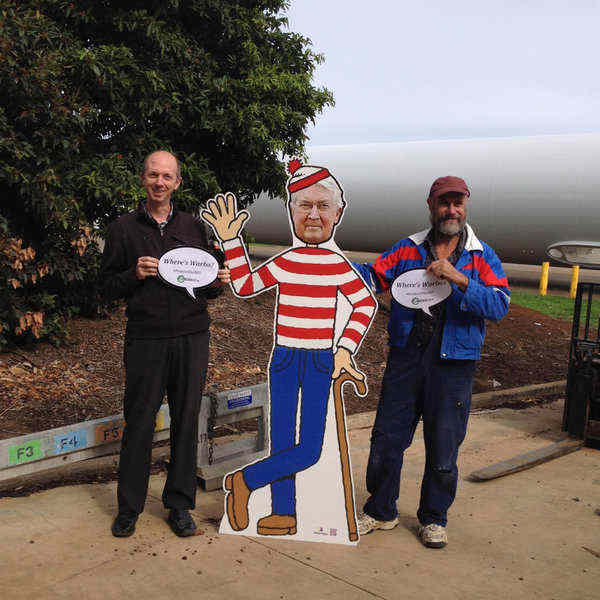
On Wednesday April 23, Friends of the Earth brought its fact-finding RET Review Road Trip to Portland, Victoria.
Previous stops in visited Hepburn/Daylesford and Morwell, provided an insight into community support for renewable energy and the costs of polluting coal energy. Our trip to Victoria’s blustery southwest coast allowed us to investigate the ways in which renewable energy can provide a platform for economic development.
With its vast wind resource, southwest Victoria is among Australia’s most important renewable energy regions.
The area is home to Pacific Hydro’s Portland Wind Energy Project. The four-stage project will see 195MW worth of generation spread over five sites. Once completed the wind energy project will generate enough electricity to power 125,000 homes (a city the size of Geelong).
Drawing on Portland’s manufacturing base and engineering expertise and generating income for turbine hosts and the community, wind energy is an engine for economic activity for Victoria’s southwest.
Portland’s Keppel Prince Engineering is at the centre of the action.
Historically, Keppel Prince gained much of its work from Alcoa’s Portland Aluminium smelter, but the firm has reoriented its business to capitalise on the burgeoning renewable energy sector. Since 2001, KP has been Australia’s largest producer of wind turbine towers and a key player in wind farm construction.

The second largest employer in town, Keppel Prince’s wind workers play a crucial role in the Australian energy sector: adapting Chinese designs to meet national specifications and manufacturing the enormous towers to support the caravan-like nacelles (the unit that houses the generator and gearbox, etc). KP workers are also involved in wind farm construction.
Keppel Prince employed as many as 100 people in its wind energy division before retrenching close to half of the work force due to uncertainty surrounding the Renewable Energy Target. The Victorian government’s anti-wind farm laws and importation of ‘below-cost’ turbine towers from China and South Korea have compounded things.
Keppel Prince has branched out into other renewables in an attempt to weather these forces.
Since 2011, Keppel Prince has installed approximately 1,300 systems across Victoria, with over 500 in the southwest. In 2012, the firm was awarded a contract to work on the pioneering Lockheed Martin/Ocean Power Technologies wave energy project that will see up to 28 buoys (68MW) installed off the coast of Portland.
Wind energy remains the cornerstone of Keppel Prince’s operations. A weakened Renewable Energy Target will drastically slash the amount of wind energy capacity installed between now and the end of the decade.
Drawing on IES Advisory modelling, Friends of the Earth estimate the Renewable Energy Target review threatens up to 3,556 construction jobs and 600 full time jobs in the wind energy sector.
“Keppel Prince’s wind energy division is ready to build world-class turbine towers,” Keppel Prince General Manager Steve Garner told me. “Keeping the Renewable Energy Target as it is will let us get to work—creating good jobs for our region.”
If Dick Warburton’s review of the Renewable Energy Target is to be taken seriously it must consider the impact on jobs. Killing job opportunities by weakening the Renewable Energy Target will make it difficult for the Abbott government to deliver its election promise of two million new jobs.

Another politician with jobs on his mind is Victorian Premier Denis Napthine. While Premier Napthine has benefitted more from renewable energy than any other politician in Australia, he has not commented on his government’s position on the Renewable Energy Target. With Keppel Prince one of the largest employer in his set, the Premier can’t stay silent for long.
Tasmanian Liberal leader Will Hodgman opposes changes to the Renewable Energy Target. One wonders whether Premier Napthine will follow suit and go into bat for renewable energy jobs in his electorate. Keppel Prince General Manager Steve Garner thinks this is a possibility:
“Premier Napthine supported our successful anti-dumping case,” explained Garner. “We’ll ask him to take another step to support Portland’s wind workers. We’ll ask him to stand up for the Renewable Energy Target.”
The Renewable Energy Target is helping to create a prosperous and resilient economy in southwest Victoria. It stands as a microcosm for Victoria and Australia. The experience of Portland can be replicated but only with a policy framework that allows the renewable energy sector to flourish.
The next stop in the RET Review Road Trip is will be a community picnic in Geelong – where renewable energy offers a lifeline for an economy struggling with the closure of Ford and Alcoa’s Point Henry Smelter.

NOTE:
- Former Caltex chairman and chair the RET review, Dick Warburton (AO LVO), was invited to attend the 11-stop fact-finding mission to help inform his review. Mr Warburton refused our invitation.
- Federal member for Wanon, Dan Tehan (Liberal), was invited but unable to attend.

Source: Yes 2 Renewables. Reproduced with permission.








